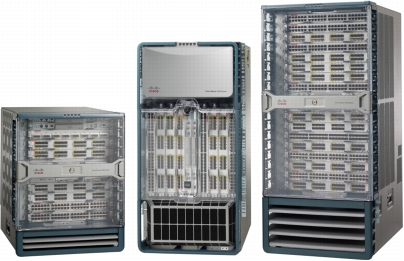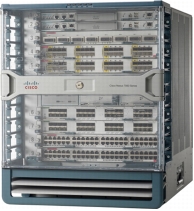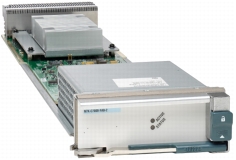PB681903
This product bulletin introduces Cisco® NX-OS Software Release 5.2 for Cisco Nexus® 7000 Series Switches (Figure 1) and summarizes the new features it offers.
Figure 1. Cisco Nexus 7000 Series Switches

New Features
• Location-ID Separation Protocol (LISP)
• Overlay Transport Virtualization (OTV) adjacency server
• Multiprotocol Label Switching (MPLS) forwarding
• MPLS Traffic Engineering (MPLS-TE) and quality of service (QoS)
• Layer 3 VPNs (L3VPNs) and route import and export between VPNs
• Multicast VPN for IPv4
• IPv6 VPN Provider Edge (6PE/VPE)
• Layer 3 routing enhancements
• Fabric extender enhancements: protocol offload, routed ports, and virtual PortChannel (vPC) support
• IEEE 1588v2 Precision Time Protocol (PTP) and Pong support
• Electronic programmable logical device (EPLD) enhancements: installation on all supervisors and parallel EPLD upgrade on I/O modules
• Additional MIB support
• XML Infrastructure enhancements
Hardware Support
• Fully modular and fully redundant Cisco Nexus 7000 9-Slot Switches
• Support for new Cisco Nexus 2000 Series Fabric Extenders
Cisco Nexus 7000 9-Slot Switches
Figure 2. Cisco Nexus 9-Slot Switch

• Support for dual dedicated supervisor modules, providing exceptionally high availability with no service interruptions even during hardware and software upgrades
• Backward compatibility with the Cisco Nexus 7000 Series supervisor module, I/O modules, and power supplies
• Highly scalable fabric architecture supporting up to five fabric modules for load-balanced, fault-tolerant operation designed to deliver 550 Gbps per slot of bandwidth
• Virtual output queue (VOQ) and fabric arbitration, delivering quality of service (QoS) and fairness across all ports, even during congestion, and providing the basis for future unified I/O
• Integrated security hardware support for Cisco TrustSec® security, providing data confidentiality while simplifying and scaling access control
• Up to 336 10 Gigabit Ethernet or Gigabit Ethernet Small Form-Factor Pluggable (SFP) or 10/100/1000 Ethernet ports in a single system for outstanding scalability
• Fully distributed forwarding engines, providing scalable packet processing and forwarding
• A series of LEDs at the top of the chassis that provide a clear summary of the status of major system components
• Variable-speed system fans, providing efficient cooling capacity to the entire system; fan redundancy features help ensure reliability of the system and provide support for hot swap of fan trays
• Up to two load-sharing power supply modules that deliver fault tolerance for a fully loaded chassis with worst-case N+1 and grid redundancy
Cisco Nexus 7000 9-Slot Fabric 2 Module
Figure 3. Cisco Nexus 7000 9-Slot Fabric 2 Module with 110 Gbps per Slot

Table 1. New Fabric Extenders Supported in Cisco NX-OS Release 5.2
Table 2. New Optics Supported in Cisco NX-OS Release 5.2
Software Support
Table 3. New Features in Cisco NX-OS Release 5.2
|
Software Features |
Description |
|
|
LISP |
LISP is an evolutionary routing architecture designed for Internet scalability and global reach across organizations. LISP Virtual Machine Mobility (VM-Mobility) is designed to enable global IP endpoint mobility across private networks as well as the Internet to provide a flexible connectivity continuum and enable global cloud computing across organizational boundaries. More information about LISP can be found at http://lisp4.cisco.com. |
|
|
OTV enhancements (adjacency server) |
In an OTV environment, the edge devices build a relationship with each other from a control-plane perspective. The neighbor relationship can be built over both multicast-enabled and unicast-only transport infrastructure. The adjacency server feature is an overlay transport mode of operation that enables unicast transport when multicast connectivity is not available. |
|
|
MPLS |
MPLS forwarding is based on label switching. Labels are allocated per prefix or per Virtual Route Forwading (VRF) instance. Label Distribution Protocol (LDP) enables exchange of labels and Interior Gateway Protocol (IGP) prefix bindings. |
|
|
MPLS QoS |
QoS mechanisms provide services such as policing, marking, and matching on MPLS-labeled packets. Differentiated services (DiffServ) models (pipe, short-pipe, and uniform modes) allow control of classification and remarking of traffic, which can be applied to applications that require more stringent service-level agreement (SLA) controls. |
|
|
MPLS-TE |
Traffic engineering provides the capability to create paths in the network to efficiently use the network fabric and bandwidth. MPLS-TE Fast Reroute (FRR) allows restoration of the traffic-engineered path (with XL modules only) in less than 50 milliseconds (ms). Link, node, path, and bandwidth protection mechanisms are supported. |
|
|
MPLS operations, administration, and maintenance (OAM) |
Label Switched Path (LSP) ping and traceroute are provided for data-path verification in MPLS networks. Tunnel ping and traceroute are provided for path verification over traffic-engineered tunnels. |
|
|
L3VPN |
L3VPNs help enable secure segmentation of customer traffic while allowing common services to be shared among customers. |
|
|
Multicast VPNv4 |
A multicast VPN is an IP VPN service that supports the transmission of IP multicast packets between sites. Cisco NX-OS implements the Rosen IETF draft. The Rosen multicast VPN service is essentially an overlay to Border Gateway Protocol (BGP) and MPLS IP VPNs. The signaling specified is Protocol-Independent Multicast (PIM), and the traffic encapsulation is Generic Routing Encapsulation (GRE). |
|
|
6PE/VPE |
6PE/VPE refers to the capability of provider-edge devices enabled with IPv6 to communicate over an MPLS-enabled core network. Multiprotocol BGP (MBGP) address families for IPv6 unicast and VPNv6 unicast are supported. |
|
|
Layer 3 routing enhancements |
Enhanced Interior Gateway Routing Protocol (EIGRP) |
• Wide metrics
|
|
Open Shortest Path First (OSPF) |
• Passive-interface default
• Summary route
• Maximum-metric link-state advertisement (LSA)
• Setting p-bit in type-7 LSA
• Cost option in area range command
|
|
|
Multicast |
• PIM register source
• Multicast over GRE
|
|
|
Fibre Channel over Ethernet (FCoE) |
FCoE support is added for N7K-F132XP-15 modules in the Cisco Nexus 7000 Series chassis. FCoE can now be deployed in director-class, highly available, modular platforms for the access layer and core of converged networks. In addition, for FCoE hosts and targets support, VE-port support allows the creation of FCoE Interswitch Links (ISLs), providing scalable, multihop FCoE topologies. The FCoE traffic in a Cisco Nexus 7000 Series Switch can be segmented using a dedicated storage virtual device context (VDC), providing exceptional segmentation and isolation of the shared physical infrastructure. With the introduction of the Cisco MDS 10-Gbps 8-Port FCoE Module, Cisco Nexus 7000 Series FCoE converged networks can be transparently bridged to Cisco MDS 9500 Series Multilayer Director Fibre Channel SANs. This features preserves existing and continued investments in Fibre Channel SANs. |
|
|
Fabric extender protocol offload |
This feature provides the capability to offload link local protocols to be run on the fabric extender. These protocols include Link Layer Discovery Protocol (LLDP) and Link Aggregation Control Protocol (LACP). |
|
|
Routed fabric extender port |
This feature enables a fabric extender port to be configured as a routed port. However, no routing protocols can be tied to this routed interface. |
|
|
Host vPC |
This feature enables a vPC to be connected from the host to two independent fabric extenders, with a Cisco Nexus 7000 Series Switch as the parent switch for the fabric extenders. The two Cisco Nexus 7000 Series Switches acting as the parent switch form the vPC peers. Note: A fabric extender is attached to the parent switch only through a local PortChannel (a fabric extender dual-attached to two parent switches is not supported). |
|
|
vPC features |
The following vPC features are supported: • Support for graceful type-1 check
• Autorecovery
• Orphan port suspension
|
|
|
Network Time Protocol (NTP) server |
The following NTP features are supported: • NTP server (unicast only)
• NTP update calendar
• NTP clock period
|
|
|
EPLD upgrade enhancements |
Upgrade can be performed on both supervisors in parallel while upgrading the Cisco NX-OS Software. Upgrade of line cards to be run in parallel, instead of the current model of sequential upgrade. This feature allows organizations to control the number of modules upgraded at one time, greatly reducing the time needed to upgrade the I/O modules and helping reduce the maintenance window. |
|
|
Parallel ISSU support |
ISSU has been enhanced to optionally provide in-service parallel upgrades of the I/O modules. This feature reduces the total time needed to complete the ISSU process while preserving the hitless upgrade capability. |
|
|
IEEE 1588v2 PTP with boundary clock function |
PTP is based on IEEE 1588v2 and is implemented on F1 modules. The implementation supports a boundary clock for network synchronization, with support for multiple slaves. The precision provided by the implementation is approximately 50 nanoseconds (ns). |
|
|
Pong |
Pong provides the capability to trace a route based on the MAC address of the destination endpoint. It provides latency and connectivity checks, using IEEE1588v2 for latency measurement. |
|
|
Unique MAC address per VDC |
From a management perspective, in the current implementation, VDCs point to a common MAC address that is shared as the source. With a unique MAC address for each VDC, customers can now manage and view a VDC as a unique device, because each VDC has a unique MAC address as an identifier. |
|
|
Access control list (ACL) capture |
ACL capture provides a mechanism for selectively monitoring traffic on a VLAN. It allows the user to enable capture for a specific ACL rule. Packets that match an ACL rule with a capture option are either forwarded or dropped based on a permit or deny action as well as copied to an alternative destination port for further analysis. |
|
|
Supported MIBs |
• BFD MIB
• LDPMIB
• LSR MIB
• TE MIB
• L3VPN
• MIB for TCP (RFC 4022)
• IP-MIB (RFC2011)
• Etherlike MIB (RFC1650)
• CISCO-ENTITY-ASSET-MIB
• CISCO-ENTITY-DISPLAY-MIB
• CISCO-ENTITY-EXT-MIB
• CISCO-ENTITY-FRU-CONTROL-MIB
• CISCO-ENTITY-SENSOR-MIB
• CISCO-ENTITY-VENDORTYPE-OID-MIB
• Q-BRIDGE-MIB
• CERT-PKI MIB Enhancements
|
|
|
XML infrastructure enhancements |
• Extensions to support NetConf
• Tools to detect backward compatibility changes
|
|
Ordering Information
• Base license: A comprehensive feature set is provided with the Base license, which is bundled with the hardware at no additional cost.
• Enterprise license: The Enterprise license enables incremental functions that are applicable to many enterprise deployments.
• Advanced LAN Enterprise license: The Advanced LAN Enterprise license enables next-generation functions such as VDCs and Cisco TrustSec security.
• Scalable Feature license: This license enables XL capabilities on the line cards. The Scalable Feature license is applied on a per-chassis basis.
• Transport Services license: This license enable OTV functions. The license to enable LISP is included in this license in Cisco NX-OS Release 5.2.
• Enhanced Layer 2 license: This license enables the Cisco FabricPath feature. The license to enable Pong is included in this license in Cisco NX-OS Release 5.2.
• MPLS license: This single license enables all MPLS features, including MPLS forwarding, QoS, L3VPN, 6PE/VPE, and OAM.
• FCoE license: This single license enables all FCoE features on the Cisco Nexus 7000 Series Switches.
• Storage license: This license enables VSAN routing and access control.
Cisco Services and Support
For More Information